ikfoundation.org
The IK Foundation
Promoting Natural & Cultural History
Since 1988


QUILTING AND PATCHWORK
– in the Whitby Area from 1700 to 1914
Sources relating to warm bed covering, quilted garments, decorative patchwork cushions, etc, have been found in the Whitby area for the 1700-1914 period, with variations in composition, quality and appearance. This particular art of sewing was so popular not only because double-layered fabrics with padding between could be made to be ornamental, beautiful and warm but also because they contributed to the recycling of surplus fabric from discarded clothes and interior furnishings in wool, cotton, silk and linen. Traditions, ownerships and trade linked to quilting and patchwork in this geographical area have been researched from contemporary handwritten documents, local newspapers, photographs, one surviving late 19th century patchwork quilt, some smaller textile objects and a zinc template.
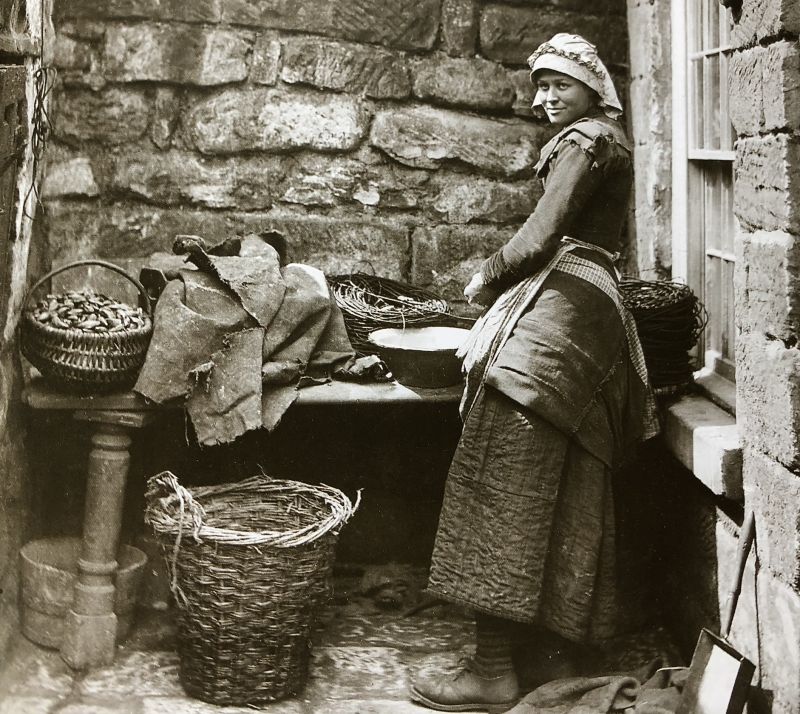 The quilting technique was not only a possibility to reuse fabric pieces for embellishment of home furnishing or for warm bedclothes, another important use was for wadded or quilted clothing. However, no such garments have been preserved in the collections of Whitby Museum, but this photograph ’Girl bating lines’ taken by Frank Meadow Sutcliffe in the nearby coastal village of Runswick Bay circa 1880, gives a detailed view of one such garment. The young woman’s quilted petticoat, worn underneath her woollen dress, was important for warmth as well as durability during hard outdoor work in the fishing communities along the Yorkshire coast. Some of women’s work included baiting lines, cleaning mussels or collecting bate along the beaches. (Courtesy of: Whitby Museum, Photographic Collection, Sutcliffe. 4-8, part of photo).
The quilting technique was not only a possibility to reuse fabric pieces for embellishment of home furnishing or for warm bedclothes, another important use was for wadded or quilted clothing. However, no such garments have been preserved in the collections of Whitby Museum, but this photograph ’Girl bating lines’ taken by Frank Meadow Sutcliffe in the nearby coastal village of Runswick Bay circa 1880, gives a detailed view of one such garment. The young woman’s quilted petticoat, worn underneath her woollen dress, was important for warmth as well as durability during hard outdoor work in the fishing communities along the Yorkshire coast. Some of women’s work included baiting lines, cleaning mussels or collecting bate along the beaches. (Courtesy of: Whitby Museum, Photographic Collection, Sutcliffe. 4-8, part of photo).The earliest written sources for this case study are probate inventories dating from the early 18th century, which give a good deal of documentation about bedclothes of various kinds, especially feather beds, bolsters, blankets and quilts. It is unknown if these quilts included patchwork, but the quilts are interesting evidence of a need in Whitby homes for very warm bedclothes, while at the same time during the period 1700-1790 these textiles were often quite valuable financially to their owners. For instance, in October 1701, the master mariner John Clark left, among much else, ‘1 feather bed, bedstead and hangings, 2 blankets and bolster and 1 quilt’ valued at ‘£2 3s 6d’. While in 1718 Christopher Hill, another master mariner, left ‘1 bedstead, feather bed, hangings, 2 blankets, 1 quilt, a pillow and bolster £1 2s’. A few years later, we find ‘George Cockerill Feb. 1725 master mariner of Bagdale near Whitby ... A bed, bedstead, curtains and blankets, 2 pillows, 1 bolster and quilt £2 10s’. The inventory of Charles Lightfoot, Bailiff of Whitby Strand, recorded in March 1743/4 that he had owned no fewer than five quilts. Bedclothes to a value of no less than £7 were left by ‘Stephen Ness in April 1757, a mariner who lately died in His Majesty’s service belonging to His Majesty’s ship the “Prince”, man of war, 2 feather beds, quilts, blankets and everything belonging thereto...’ The shipwright William Goulton’s probate in March 1790 is the last such example, with ‘2 quilts £1’.
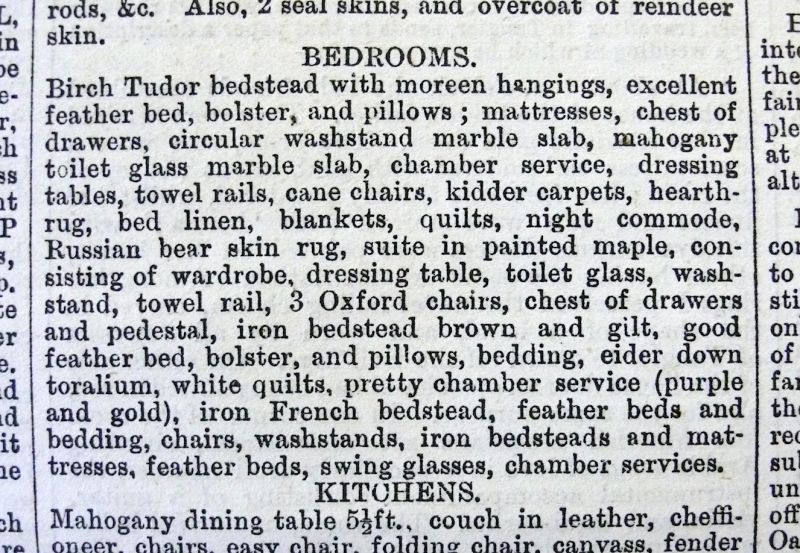 Auction of Household Furniture via the auctioneer/valuer Robert Gray, part of advertisement which listed objects in ‘Bedrooms’ – including ‘Quilts’ – published in Whitby Gazette in May 1880. (Collection: Whitby Museum, Library & Archive). Photo: Viveka Hansen, The IK Foundation.
Auction of Household Furniture via the auctioneer/valuer Robert Gray, part of advertisement which listed objects in ‘Bedrooms’ – including ‘Quilts’ – published in Whitby Gazette in May 1880. (Collection: Whitby Museum, Library & Archive). Photo: Viveka Hansen, The IK Foundation.
Advertisements and other information in the local newspaper confirm that quilts continued to be popular into the 20th century. In the 1911 census, the 63-year-old widow Elizabeth Blenkey gives her occupation as ‘Quilter Needlework’; perhaps she was a supplier to one of the shops in the town that sold hand-sewn quilts at that time. That quilts were so often mentioned in the Whitby Gazette between 1855 and 1914 is an additional indication that such textiles must also have been in general use in the Whitby area during the earlier period from 1790 to 1855, even if there is no written evidence or surviving quilts from that period.
It is evident that quilts were sold by a variety of textile dealers. Robert Gray & Co. was one of the firms that regularly advertised bedlinen, for instance, in November 1878 with ‘Linens, Calicoes, Sheets and Quilts’ in the local paper. The Furnishing Department of Wellburn Brothers placed a similar advertisement in spring 1885 for ‘Sheetings, Quilts, Blankets &c. &c.’ While Lambert & Warters in spring 1900 simply offered ‘Quilts’. In the same way ‘quilts’ were auctioned as Household Furniture in the spring of 1880 (image above), in fact, quilts were frequently auctioned during the second half of the 19th century. Other similar advertisements included an auction from a farmer’s home in November 1860 that mentioned ‘Quilts’; a household auction by Hinderwell in spring 1870 including ‘6 Quilts’; and on 1st & 2nd May 1905, an auction from the White House Hotel in Whitby that offered bidders ‘4 coloured quilts’.
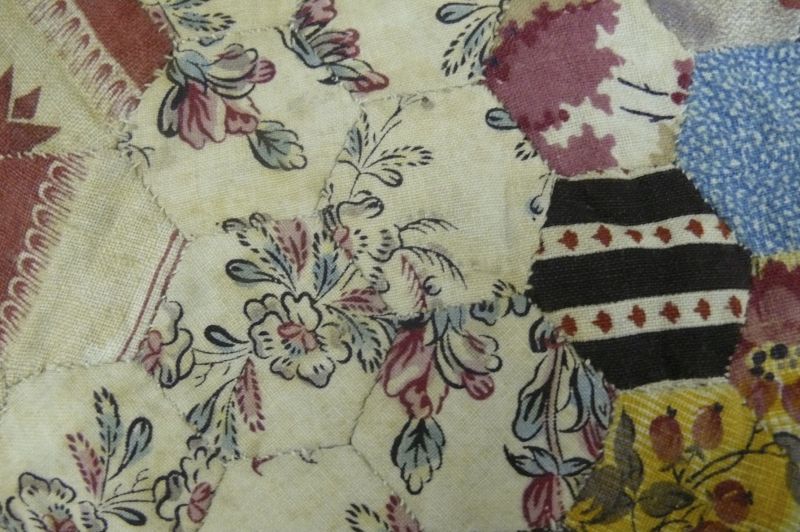 A patchwork quilt intended for a child’s bed, with small hexagonal patches sewn on by hand with white thread. These patches are arranged into what was commonly described as ‘Grandmother’s Flower Garden’. This little coverlet edged with a border measures 117cm by 138cm. Notwithstanding all the work that clearly went into it, the quilt was never completely finished, and one can still see tacking stitches along the edges and the padding and backing was never added. Moreover, the patchwork illustrated has been sewn with unusually small hexagons only an inch (2.54 cm) wide in printed cotton of every conceivable colour, but with blue and mauve dominant. The particular strong shade of mauve used proves that the fabric must date from after 1856, when aniline first made this shade of dye common. Mauve was never more popular than in the 1860s, so this patchwork probably mostly consists of left-over clothes/fabrics from that period, and itself was probably put together in the 1870s or 1880s (Collection: Whitby Museum, Costume Collection, GBB 125). Photo: Viveka Hansen, The IK Foundation.
A patchwork quilt intended for a child’s bed, with small hexagonal patches sewn on by hand with white thread. These patches are arranged into what was commonly described as ‘Grandmother’s Flower Garden’. This little coverlet edged with a border measures 117cm by 138cm. Notwithstanding all the work that clearly went into it, the quilt was never completely finished, and one can still see tacking stitches along the edges and the padding and backing was never added. Moreover, the patchwork illustrated has been sewn with unusually small hexagons only an inch (2.54 cm) wide in printed cotton of every conceivable colour, but with blue and mauve dominant. The particular strong shade of mauve used proves that the fabric must date from after 1856, when aniline first made this shade of dye common. Mauve was never more popular than in the 1860s, so this patchwork probably mostly consists of left-over clothes/fabrics from that period, and itself was probably put together in the 1870s or 1880s (Collection: Whitby Museum, Costume Collection, GBB 125). Photo: Viveka Hansen, The IK Foundation.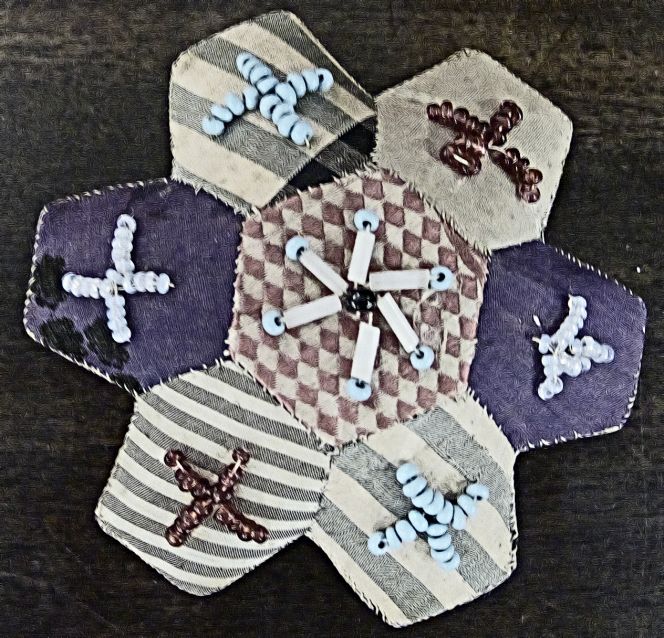 When doing patchwork one preferably need templates made from some strong, durable material that would enable, for example, to cut out hundreds of paper hexagons identical in size and shape as models for pieces of cloth. The Whitby Museum Social History collection contains a rhombus shaped zinc template, together with the beginnings of two pieces of patchwork and two patchwork pin-cushions. The simpler of these pin-cushions has been made from pentagons of various colours sewn together, while the other – illustrated here – was made up from seven hexagons with each of the sections further decorated with a collection of small beads. Objects dated to around the 1880s to the 1910s. (Collection: Whitby Museum, Social History Collection, unnumbered at time of research.) Photo: Viveka Hansen, The IK Foundation.
When doing patchwork one preferably need templates made from some strong, durable material that would enable, for example, to cut out hundreds of paper hexagons identical in size and shape as models for pieces of cloth. The Whitby Museum Social History collection contains a rhombus shaped zinc template, together with the beginnings of two pieces of patchwork and two patchwork pin-cushions. The simpler of these pin-cushions has been made from pentagons of various colours sewn together, while the other – illustrated here – was made up from seven hexagons with each of the sections further decorated with a collection of small beads. Objects dated to around the 1880s to the 1910s. (Collection: Whitby Museum, Social History Collection, unnumbered at time of research.) Photo: Viveka Hansen, The IK Foundation.There is also a tea cosy in crazy velvet patchwork in the same Social History collection, using a technique that consisted of uneven pieces of cloth in a motley of different colours usually sewn together in feather stitch, an idea popular in the 1880s when it was illustrated in many ladies’ magazines. This patchwork technique was also known as ‘American Patchwork’, ‘Kaleidoscope Pattern’ or ‘Puzzle’, and its free technique permitted a blending of fabrics, forms, stitches and other effects to create something completely new. While recycling discarded pieces of clothing, the embroiderer was able to have more free artistic ambitions with effective stitches, pieces of ribbons, etc and by using what would once have been unthinkable combinations of fabric and colour to make furnishing details that would have been ground-breaking at the time.
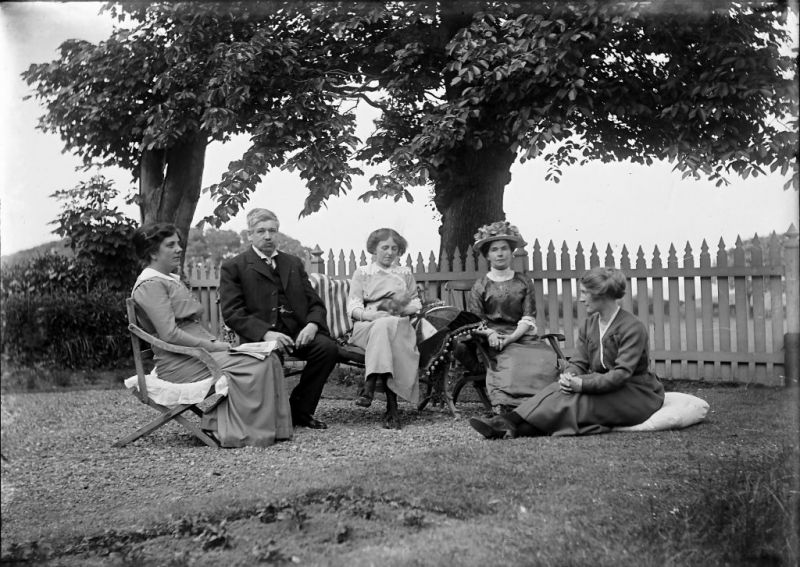 A final photograph dated to circa 1910 – of a family group at Stakesby in Whitby sitting in the garden on cushions – reveals several details of interest. In particular the centred lady who rests her arm on a large-sized cushion with a circle-shaped patchwork design made-up of various fabrics, together with darker coloured velvet for the corner sections and a striking decorative ball fringe. Even if upholstered furniture was preferred for chairs and sofas, it was a frequent habit of sitting on loose cushions, a usage that survived into the early 20th century also in well-off homes. Loose cushions were especially practical out of doors, as can be clearly seen in this picture of the Botham family, where various types of cushions have been taken out to enable them to sit in comfort in the garden. (Courtesy of: Whitby Museum, Photographic Collection, 2002/13.16. unknown photographer).
A final photograph dated to circa 1910 – of a family group at Stakesby in Whitby sitting in the garden on cushions – reveals several details of interest. In particular the centred lady who rests her arm on a large-sized cushion with a circle-shaped patchwork design made-up of various fabrics, together with darker coloured velvet for the corner sections and a striking decorative ball fringe. Even if upholstered furniture was preferred for chairs and sofas, it was a frequent habit of sitting on loose cushions, a usage that survived into the early 20th century also in well-off homes. Loose cushions were especially practical out of doors, as can be clearly seen in this picture of the Botham family, where various types of cushions have been taken out to enable them to sit in comfort in the garden. (Courtesy of: Whitby Museum, Photographic Collection, 2002/13.16. unknown photographer). Sources:
- Brears, Peter, North Country Folk Art, Edinburgh 1989.
- Hansen, Viveka, The Textile History of Whitby 1700-1914 – A lively coastal town between the North Sea and North York Moors, London & Whitby 2015 (pp. 77-78 & 335-337).
- North Yorkshire County Library, Whitby (Census 1841-1901 microfilm & 1911 digital).
- Vickers, Noreen, A Yorkshire town of the 18th century, Whitby 1986.
- Whitby Gazette, 1855-1914. (Whitby Museum, Library & Archive).
- Whitby Museum (Whitby Lit. & Phil.) Whitby, UK. (Research was made from 2007 to 2010, in the collections of Costume & Textile, Photographs and Social History).
More in Books & Art:
Essays
The iTEXTILIS is a division of The IK Workshop Society – a global and unique forum for all those interested in Natural & Cultural History from a textile Perspective.
Open Access essays, licensed under Creative Commons and freely accessible, by Textile historian Viveka Hansen, aim to integrate her current research, printed monographs, and earlier projects dating back to the late 1980s. Some essays feature rare archive material originally published in other languages, now available in English for the first time, revealing aspects of history that were previously little known outside northern European countries. Her work also explores various topics, including the textile trade, material culture, cloth manufacturing, fashion, natural dyeing, and the intriguing world of early travelling naturalists – such as the "Linnaean network" – viewed through a global historical lens.
For regular updates and to fully utilise iTEXTILIS' features, we recommend subscribing to our newsletter, iMESSENGER.
been copied to your clipboard




– a truly European organisation since 1988
Legal issues | Forget me | and much more...
You are welcome to use the information and knowledge from
The IK Workshop Society, as long as you follow a few simple rules.
LEARN MORE & I AGREE







